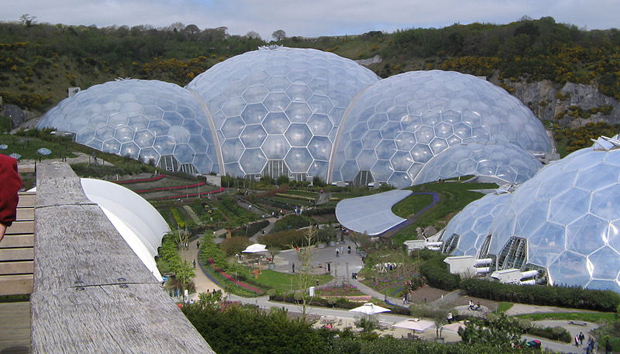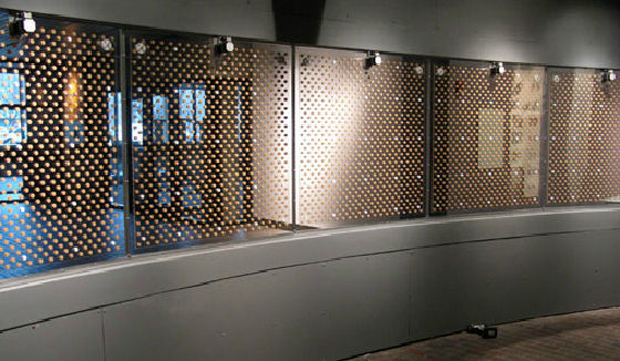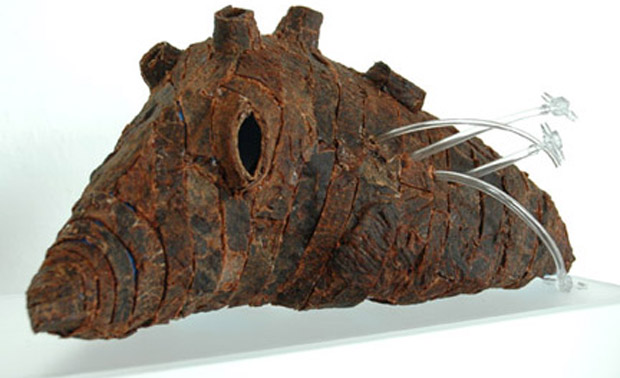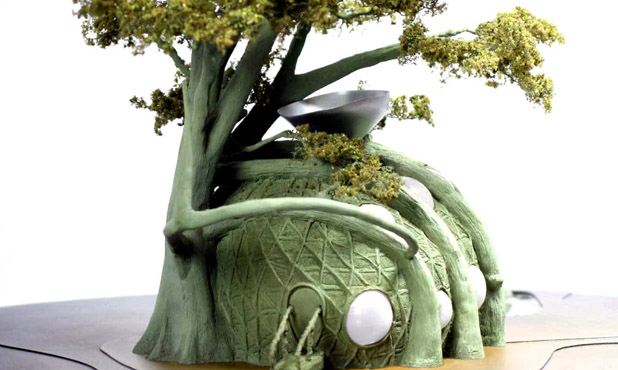Above: The Fab Tree Hab by Mitchell Joachim, Javier Arbona and Lara Greden presents a sophisticated methodology to grow homes from living native trees. The 100% living habitat is prefabricated using Computer Numeric Controlled (CNC) reusable scaffolding, manufactured off-site in advance. Scaffold sections can be readily shipped and assembled to fit local tree and woody plant species. Image via Archinode.com
Imagine a future in which our buildings act and react to environmental conditions like living organisms, facades breathe through self-activating apertures, building structural systems weigh a mere fraction of what they do today, and they can even grow themselves! These are just a few of the innovations currently taking place at the cutting edge of architectural design thanks to a small group of architects looking to biology for inspiration. Their aim is to discover more sustainable building practices, better integration of human settlements with the environment, and ecological cities in which organisms, environment, and climate operate together to create a holistic, coherent web. They are asking important questions: How can we build our cities to be more resilient? How can buildings react, adapt, and work together to maximize resource efficiency, reduce our dependence on fossil fuels and our carbon footprint? How can our waste stream be transformed from a linear system to a closed loop where the waste streams from one process become the nutrient source of another?
In the current practice of development and construction, buildings tend to function in isolation from one another and utilize resources in very inefficient ways through the use of single functioning design elements each with its own use and purpose. Nature, on the other hand, has evolved multifunctional elements with the ability to respond and adapt to various phenomenon. Biologically-inspired architecture looks to these natural models to find solutions for these problems and concerns. In this article we will look at four emerging trends in bio-inspired architecture: biomimicry, biomaterials, adaptive architecture, and living architecture.
Biomimicry
Biomimicry, or the study of nature’s models and applying their designs and processes to human problems, is one of the leading trends in this research, and can be understood as the meta-theme which encompasses the others. Mimicry as a design trope has been in practice at least since the Greeks designed stone temples resembling trabeated wood construction techniques. Nature as a source for architectural inspiration, particularly for ornamentation, was popular until the early twentieth centuries until it was replaced by the machine as inspiration by early Modern masters such as Le Corbusier. I prefer to distinguish between shallow and deep mimicry in architecture. Shallow mimicry remains at a surface level understanding of a model, such as its formal qualities or how it looks. Deep mimicry, on the other hand, is more fascinated with a model’s performance or behavior and how it is achieved. Many architects recently have looked to natural models as inspiration for more efficient structural forms. British architect Nicholas Grimshaw’s Eden project, a giant biodome constructed in Cornwall, England in 2000, was inspired by biomimicry in three profound ways. The building form was computationally modeled using algorithms based on soap bubble geometry to find structurally efficient forms with flexibility to respond to various ground conditions. The structural system was inspired by sea sponges and radiolarian to create geometries that more effectively transfer loads. Finally, the transparent skin utilizes a pressurized membrane similar to many organisms that allows it to span up to seven times greater than glass at 1% of the weight of glass, further reducing the amount of steel required and allowing maximum transparency.

Adaptive Architecture
“Bioinspired adaptive architecture” is a phrase used by Donald Ingber to describe how architects can learn from the transformational qualities of biological models that allow them to react and adapt to various external factors to optimize their performance. One example is the “Adaptive Fritting” facade system developed by Chuck Hoberman and Buro Happold. Their design incorporates a dynamically reconfigurable graphic pattern that can modulate its transparency to control transmitted light, solar gain, privacy and views. Multiple layers of clear sheets, each with its own pattern of opaque ceramic fritting, shift in relation to each other so that the graphic pattern alternately aligns and diverges to create an infinite variety of patterns based on the shape, color, and scale of the frit. According to Ingber, this is reminiscent of the skin of certain amphibians that change the color of their skin by moving spherical packets that contain pigment through their cells which allowing the cells to shift from light to dark to react to ambient light conditions. When all the packets are concentrated at one point it appears clear or light colored, and when the packets are distributed the cells appear dark and restrict light transmission.

Materials Research
Biological inspiration is also leading to advances in material science, from synthetic nanomaterials that mimic the properties of natural materials to exploiting the intrinsic qualities of natural materials for novel purposes. Joanna Aizenberg, a bioengineer at Harvard University, describes her research as ‘extreme biomimetics’, and involves a two-step process. First, look to nature to find something amazing, and second, mimic that behavior and develop high tech solutions that outperform anything we have available today. ‘Superhydrophobic Si’, or SLIPS, an incredible material developed by Aizenberg, was inspired by the carnivorous pitcher plant. When the plant’s rim gets wet – either from a nectar or humidity in the air – it becomes so smooth that an insect standing on it slips into the pitcher where they are consumed. The SLIPS product will not allow any liquid to stick to its surface, including no ice accumulation to -25 degrees Centigrade. This novel material could be useful in many applications – oil transport and storage, medical devices, airplane wings, buildings, and more – which also demonstrates the interdisciplinary collaboration at the heart of bioengineering.
Achim Menges is an architect and professor at the University of Stuttgart who has an ongoing research project exploring the potential of natural materials to react to ambient climatic conditions, such as the hygroscopic and meteorosensitive qualities of wood fibers. In the ‘Responsive Surface Structure’ Menges and his students developed a surface comprised of small wood veneer elements that open and closes due to changes in the relative humidity of the air. This modulates the porosity and the related cross-ventilation of the surface, without the need for any additional mechanical control devices. The effect is based on the biomimetic principle of materially-ingrained responsiveness, or the way that nature has evolved a variety of dynamic systems interacting with climatic influences. The hygroscopic nature of wood can be observed in the opening of spruce cones, which occurs when the air is drier, assuring the seeds are dispersed during dry weather so that the distance traveled from the parent tree will be enhanced.
Living ARCHITECTURE

With the introduction of 3d printing, self-replicating robots, and tissue engineering, architects are interested in exploring novel methods for the construction of buildings. Mitchell Joachim is a New York-based architect exploring how to engineer living tissue into a viable building product. His Vitro Meat Habitat and Fab Tree Hab (see figure at top) projects utilize engineered animal tissues and living trees, respectively. Joachim and his research lab, Terreform One, are also exploring how to scale up this technology beyond building scale into something they call ‘biological urbanism’. Conceptual designs such as their proposals for Downtown Brooklyn and the Brooklyn Navy Yard propose self-reliant urban districts with an interwoven mesh of vertical agriculture, housing merged with infrastructure, renewable energy integrated into ecological pathways and plazas, all designed to create a robust urban metabolism.
More Cross Disciplinary Collaboration is Needed
Cross disciplinary collaboration between bioengineers and architects is a promising field with potential to radically revolutionize the way we design, build, and conceive our buildings and cities in the future. At present this collaboration is only being explored tentatively. This is unfortunate because I believe bioengineers and architects have much to learn from one another. Biologists and bioengineers offer architects a new framework and scientific method to approach the issues of rapid urbanization, sustainability, and climate change. Architects and designers provide bioengineers with a way of thinking that focuses on both real world solutions for today and speculation about the future. On one hand it is an issue of scale – bioengineers focus on a micro scale and architects and designers can help bridge the gap to meso-scale by identifying problems and opportunities in the building and product industries. Designers are trained to articulate people’s needs and desires in order to design devices they will actually use. On the other hand, through a projective process focusing on the long-term designers can envision radical new bio-inspired solutions requiring collaboration with bioengineers to realize.



